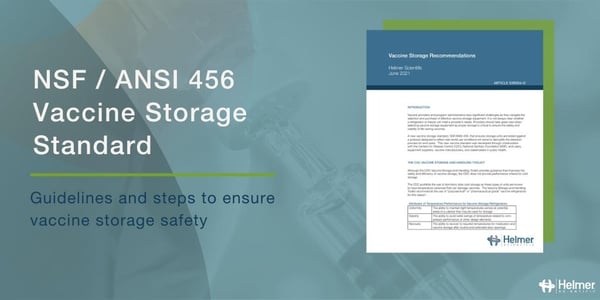Safe vaccine storage and handling, including the use of appropriate vaccine refrigerators and freezers, has continued to be a priority for the U.S. Centers for Disease Control (CDC) as part of its mission to increase the health security of the United States. CDC recommendations can be found in the CDC Vaccine Storage and Handling Toolkit and have been a critical resource for state health departments and providers managing immunization programs.
Recently, a new NSF/ANSI 456 Vaccine Storage Standard was published to provide clinicians an additional tool to support safe vaccine storage by defining performance characteristics and other attributes of vaccine refrigerators and freezers.
In 2012, a Department of Health and Human Services study evaluated vaccine storage and handling at Vaccine for Children (VFC) provider sites. This report reinforced the need for continuing education and guidance to ensure the safety of vaccines, as 76 percent of VFC sites surveyed had exposed vaccines to temperatures outside of recommended ranges for at least a five-hour period.
Since 2012, additional tools and resources have been made available to help providers support vaccine safety. The CDC Vaccine Storage and Handling Toolkit, originally launched in 2014 and last updated in September 2021, has been continuously updated to help promote proper vaccine storage throughout the cold chain.
Examples of recommendations in the CDC Vaccine Storage and Handling Toolkit include:
- Use purpose-built or pharmaceutical-grade cold storage that has been designed to safeguard vaccines. These refrigerators and freezers typically have features such as microprocessor-based temperature control, self-closing doors, alarms, and forced-air circulation to help ensure fast temperature recovery and uniformity.
- Monitor temperatures with an appropriate Temperature Monitoring Device, or Digital Data Logger (DDL), that records temperatures at preset intervals, and not just minimum and maximum temperatures. DDLs may be standalone devices or integrated into vaccine refrigerators and freezers. Additional CDC recommendations for DDL requirements include, but are not limited to:
-
Buffered probes to simulate vaccine temperature
-
Alarms and indicators for temperature excursions and low batteries
-
Valid Certificate of Calibration issued by an appropriate entity (e.g., conformance to ISO17025 standards for calibration testing and traceability)
-
In addition to recommendations in the CDC Vaccine Storage and Handling Toolkit, the Joint Committee on Vaccine Storage published a new standard in 2021 to further promote vaccine storage safety. This committee, comprised of providers, public health agencies, vaccines storage equipment suppliers, and vaccine manufactures developed the NSF/ANSI 456 Vaccine Storage Standard. This new standard goes an additional step beyond current recommendations in the CDC Vaccine Storage and Handling Toolkit by further defining appropriate vaccine refrigerators and freezers by creating temperature performance requirements.
These temperature performance requirements are tested through a series of evaluations that simulate real-world use of vaccine storage equipment. This includes testing using various door-open and vaccine-loading conditions common at healthcare facilities. The standard is designed to ensure a vaccine storage refrigerator or freezer will maintain temperature within recommended ranges during normal use and will recover temperatures quickly after extended door openings.
For a vaccine refrigerator or freezer to be certified to the new NSF/ANSI 456 standard, there are additional requirements outside of just temperature performance. Examples include the need for a Certificate of Calibration, incorporating digital temperature displays and visual/audible alarms on the vaccine storage unit, and labeling the product with storage volume/capacity using a standard method for measurement. Manufactures can certify vaccine refrigerators and freezers to the new standard through third-party testing laboratories.
OTHER BLOGS YOU MIGHT BE INTERESTED IN...
- Emerging Standards for Vaccine Storage in 2021
- Medical-grade vaccine storage can help prevent vaccine and financial loss
- Explaining the NSF / ANSI 456 Vaccine Storage Standard
- Helmer's GX Solutions Certified to NSF/ANSI Vaccine Storage Standard
As guidelines and standards continue to improve to help further safeguard life-saving vaccines, it is critical that equipment suppliers provide products that support evolving needs.
To learn more about Helmer Scientific models certified to the new NSF/ANSI 456 Vaccine Storage standard, please visit our website.





